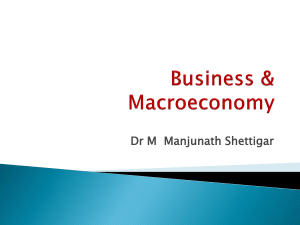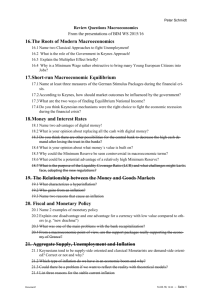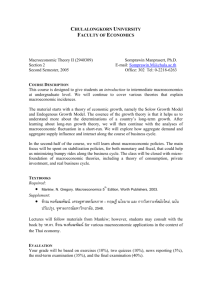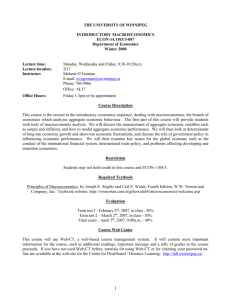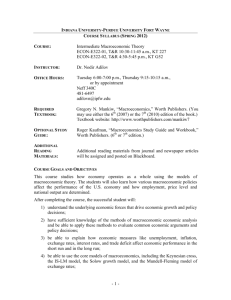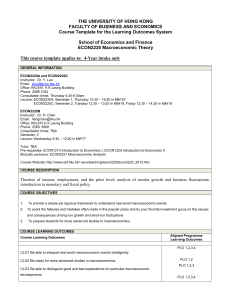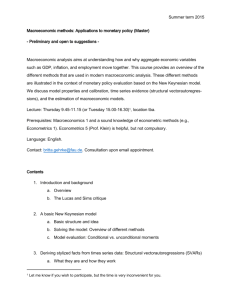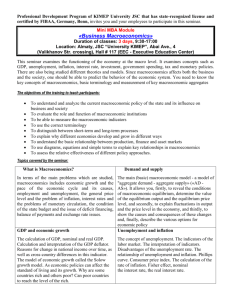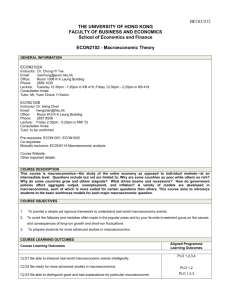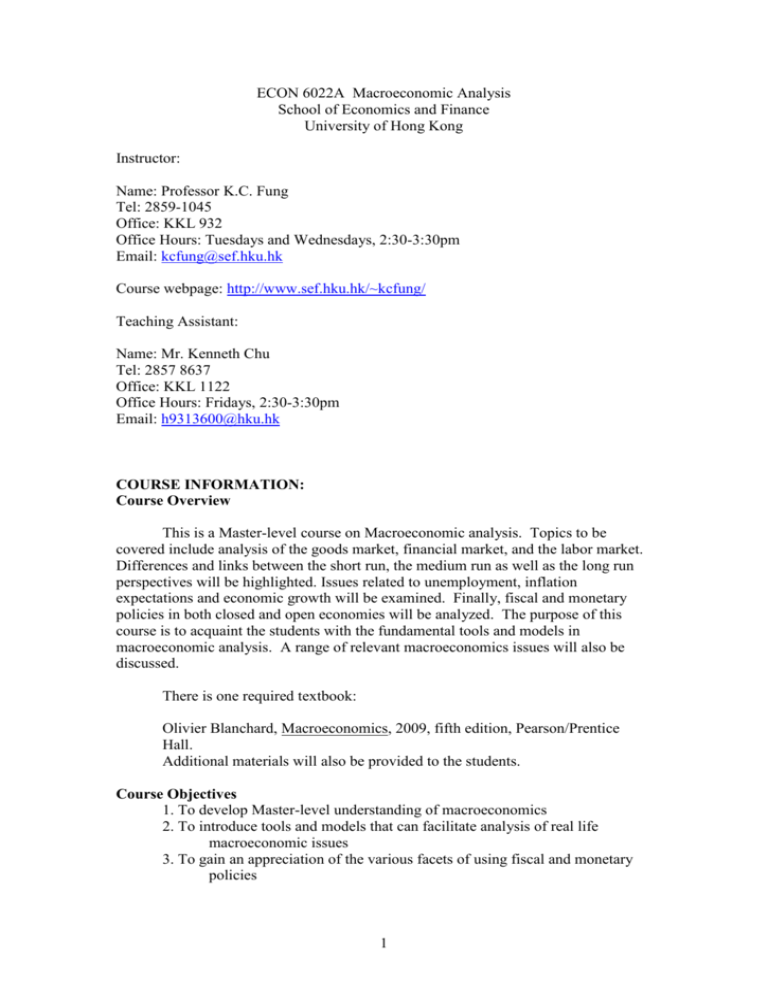
ECON 6022A Macroeconomic Analysis
School of Economics and Finance
University of Hong Kong
Instructor:
Name: Professor K.C. Fung
Tel: 2859-1045
Office: KKL 932
Office Hours: Tuesdays and Wednesdays, 2:30-3:30pm
Email: kcfung@sef.hku.hk
Course webpage: http://www.sef.hku.hk/~kcfung/
Teaching Assistant:
Name: Mr. Kenneth Chu
Tel: 2857 8637
Office: KKL 1122
Office Hours: Fridays, 2:30-3:30pm
Email: h9313600@hku.hk
COURSE INFORMATION:
Course Overview
This is a Master-level course on Macroeconomic analysis. Topics to be
covered include analysis of the goods market, financial market, and the labor market.
Differences and links between the short run, the medium run as well as the long run
perspectives will be highlighted. Issues related to unemployment, inflation
expectations and economic growth will be examined. Finally, fiscal and monetary
policies in both closed and open economies will be analyzed. The purpose of this
course is to acquaint the students with the fundamental tools and models in
macroeconomic analysis. A range of relevant macroeconomics issues will also be
discussed.
There is one required textbook:
Olivier Blanchard, Macroeconomics, 2009, fifth edition, Pearson/Prentice
Hall.
Additional materials will also be provided to the students.
Course Objectives
1. To develop Master-level understanding of macroeconomics
2. To introduce tools and models that can facilitate analysis of real life
macroeconomic issues
3. To gain an appreciation of the various facets of using fiscal and monetary
policies
1
4. To prepare students to critically think about topics related to inflation,
unemployment and exchange rates
INTENDED LEARNING OUTCOMES
On completion of this course, students should be able to:
CILO1 Explain observed macroeconomic issues such as inflation and unemployment
CILO2 Analyze the effects of government policies such as fiscal policy and monetary
policy
CILO3 Understand and evaluate the macroeconomic situations of economies that are
closed and those that are open
CILO4 Critically discuss macroeconomic and exchange rates issues verbally as well
as in written forms
ALIGNMENTS OF PROGRAM AND COURSE LEARNING OUTCOMES:
Program Intended Learning Objectives
1. Acquisition and internalization of Master-level Macroeconomics knowledge
CILO1, CILO2, CILO3, CILO4
2. Application and integration of knowledge
CILO1, CILO2, CILO3, CILO4
3. Developing Global Outlook
CILO1, CILO2, CILO3, CILO4
4. Mastering communication skills
CILO4
TEACHING AND LEARNING ACTIVITIES
TLA1. Lectures:
The Instructor will give lectures on major concepts, issues and models
TLA2. Consultation:
Both the instructor and the teaching assistant will hold consultation hours to
address students’ questions. Students are also encouraged to discuss questions
with the instructor and TA by email
TLA3 Extra Credit Short Paper:
The students can also write a 3-page paper on a relevant macroeconomic topic
for extra credit
Assessment:
A1 Midterm
A2 Final Exam
A3 Short Paper
40%
60%
10%
2
Relationship among Intended Learning Outcome, Teaching and Learning
Activities and Assessments
CILO
1
2
3
4
TLA
TLA 1-3
TLA 1-3
TLA1-3
TLA 2-3
A
A1&2
A1&2
A1&2
A2&3
CLASS SCHEDULE
Topic 1: Introduction to Macroeconomics
A Tour of the World, Chapter 1
A Tour of the Book, Chapter 2
Topic 2: The Short Run Analysis
The Goods Market, Chapter 3
The Financial Market, Chapter 4
Topic 3: IS-LM Model, the Labor Market
Goods and Financial Markets, Chapter 5
The Labor Market, Chapter 6
Topic 4: The AS-AD Model and the Phillips Curve
Putting All Markets Together, Chapter 7
The Natural Rate of Unemployment and the Phillips Curve, Chapter 8
Topic 5: Inflation, Money and Economic Growth I
Inflation, Activity, and Nominal Money Growth, Chapter 9
The Facts of Growth, Chapter 10
Topic 6: Economic Growth II and III
Saving, Capital Accumulation and Output, Chapter 11
Technological Progress and Growth, Chapter 12
Midterm: October 21, 2009
Topic 7: Technological Progress, Expectations
Technological Progress: The Short, the Medium and the Long Run,
Chapter 13
Expectations: The Basic Tools, Chapter 14
Topic 8: Expectations, Financial Markets, Consumption and Investment
Financial Markets and Expectations, Chapter 15
Expectations, Consumption, and Investment, Chapter 16
Topic 9: Expectations and Policies, Openness
Expectations, Outputs and Policy, Chapter 17
Openness in Goods and Financial Markets, Chapter 18
Topic 10: Openness II
The Goods Market in an Open Economy, Chapter 19
Output, the Interest Rate and the Exchange Rate, Chapter 20
Topic 11: Exchange Rates and the Open Economy
Exchange Rate Regimes, Chapter 21
3
4

